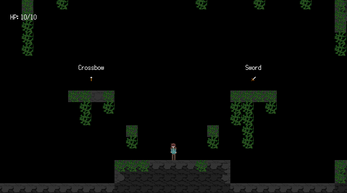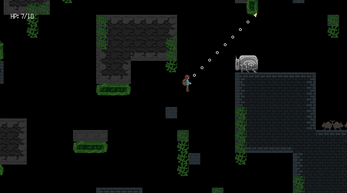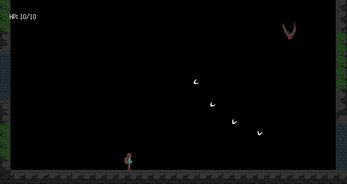The Myth of Fanatras
A downloadable game
The Myth of Fanatras is a single player, 2D platformer where the player must use the treasures of an ancient ruin to escape back to the surface. The player is an explorer who finds themselves at the entrance to the ancient Temple of Fanatras. Upon getting closer, they fall down a pitfall trap that leads them deep into the caverns below. Armed with nothing, the player must find the temple’s artifacts and use them to find their own path back to the surface.
The player must make choices between which artifacts to take with them. Between the sword and the crossbow, or the double jump boots and the grappling hook, only one of each can be chosen, and that choice sticks with you for the rest of the game. There are two levels with a path divergence depending on what you chose in the first level.
The game's four upgrades are:
- Sword - A short ranged attack with high damage.
- Crossbow - A long ranged attack with low damage.
- Double Jump Boots - Allows the player to jump twice.
- Grappling Hook - An extending hook that stuns enemies and pulls the player towards certain types of wall.
Controls:
- Arrow keys to move
- Z - Attack
- X - Jump
- C - Crouch (use this to aim ranged items!)
- V - Use grappling hook (if you have it!)
POST-MORTEM
- What Went Right
- The grappling hook works fairly well. From a coding perspective, a lot of aspects of the project started to fit into place the farther we progressed. Especially when coding animation control, which was surprisingly painless and effortless.
- The gradual increase in difficulty along with when new enemies were introduced to the player, as well as implementing the “randomness” of cave and ruin environments was satisfactory.
- The animation for the bat turned out better than expected, and changing the direction the character faces worked out well.
- The grappling hook works fairly well. From a coding perspective, a lot of aspects of the project started to fit into place the farther we progressed. Especially when coding animation control, which was surprisingly painless and effortless.
- What Went Wrong
- Programming - The game does not have the ability to save or load data. This meant a lot of things had to coded around that inability, especially in regards to Game Overs and the checkpoint system. The way it’s handled in the final version isn’t ideal, as the room does not reset after death, but it was decided this was fine enough for the game.
- Level Design - One issue we faced was where tiling occasionally wouldn’t save, with the worst incident being half of level 1’s terrain tiling not saving. we also realized that we couldn’t accurately test levels from the perspective of a new player as we knew where to go, so we had to go back to previous obstacles and ensure that there was at least one clear path.
- Art - The original plan included a number of art and animations, but a lot got cut out. In addition, some of the sprites and textures didn’t end up feeling completely stylistically similar.
- Programming - The game does not have the ability to save or load data. This meant a lot of things had to coded around that inability, especially in regards to Game Overs and the checkpoint system. The way it’s handled in the final version isn’t ideal, as the room does not reset after death, but it was decided this was fine enough for the game.
- What We Changed
- Some of the boss patterns were changed from the original plan. This was mostly done for practical purpose. Some of the patterns were a bit complex and we were running low on time.
- There were originally going to be puzzle elements (using the sword to break blocks or using the crossbow to activate switches), but we couldn’t figure it out early on and it fell to the wayside after we had already designed level 1.
- There was originally going to be a poisonous water hazard, and the beetle would be used in clearing it, but we never got around to it.
- Something planned at a few stages of development was a health upgrade and pickup, but it never came to fruition
- The camera system was not part of the original plan. It was added a good ways into Level 1’s development and has been an important feature since.
- Some of the boss patterns were changed from the original plan. This was mostly done for practical purpose. Some of the patterns were a bit complex and we were running low on time.
- What We Learned
- It’s important to consider how all of the parts of the game fit together. A game is a system of interacting objects, and small design decisions can have far reaching consequences.
- To use as few instances of terrain objects as possible, as large numbers of them will cause Gamemaker to become laggy.
- We learned a new appreciation for testers as we spent more time testing the levels than building the levels.
- Creating sprites and textures and animations takes a lot of time.
- Communication is very important in game development. It’s critically important that everyone keeps track of each other.
- It’s important to consider how all of the parts of the game fit together. A game is a system of interacting objects, and small design decisions can have far reaching consequences.
| Status | Prototype |
| Author | JFought |
| Genre | Platformer |
| Tags | 2D, GameMaker, Singleplayer |
| Average session | A few minutes |
| Languages | English |
| Inputs | Keyboard |
Download
Install instructions
Make sure to extract before playing. It's a .exe file so Windows Defender will get angry at you: just click More Info then Run Anyway.



Leave a comment
Log in with itch.io to leave a comment.